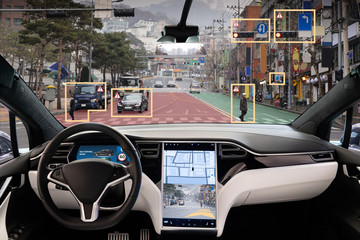Automated Driving Levels: From Level 0 to Level 5
Read Time 5 mins | Written by: Anuj Kharnal

As the world moves closer to a future of automated vehicles, the term "self-driving car" often gets thrown around. However, not all self-driving technologies are created equal. The levels of automation range from Level 0, where the human driver is entirely in control, to Level 5, where the vehicle is fully autonomous. This blog aims to demystify these levels and provide a clear understanding of what each entails.
Understanding the Levels
The complexity of automated driving is often underestimated, largely because people are not familiar with the gradations that exist in this technology. Developed by the Society of Automotive Engineers (SAE), the J3016 standard delineates six levels of driving automation, from Level 0 to Level 5. These levels serve as a global benchmark for understanding and discussing vehicle automation, and each comes with its own set of capabilities and limitations.
Level 0: No Automation
At Level 0, all driving tasks are performed by the human driver. This includes steering, braking, accelerating, and even simpler tasks like turning on the wipers or using turn signals. While there might be warnings or momentary intervention systems, such as basic collision warnings, these are merely advisory and do not replace any driving functions.
Example: Most vehicles manufactured before the advent of ADAS technology fall under Level 0. These cars might have some basic warning systems, like a simple alert if you're running low on fuel, but there's no automation involved in the driving itself.
Level 1: Driver Assistance
Level 1 automation involves a single automated system to assist the driver. For example, a vehicle might have adaptive cruise control, which can adjust the vehicle's speed to maintain a safe following distance. However, the human driver is still responsible for steering and must remain engaged with the task of driving at all times.
Example: Many modern family cars fall into this category. Take the Honda Accord, for instance. Its adaptive cruise control can maintain a set speed and slow down if it detects a vehicle in front, but steering and all other driving tasks are entirely up to the human driver.
Level 2: Partial Automation
At Level 2, the vehicle can manage both steering and speed, but the human driver must remain attentive and engaged. The driver is still responsible for most safety-critical functions and must be ready to take control of the vehicle at any moment.
Example: Tesla's Autopilot is perhaps the most well-known Level 2 system. While it can control both speed and steering, it requires the driver's hands to be on the wheel at all times. Another example is Volvo's Pilot Assist, which offers similar functionalities but also requires driver supervision.
Level 3: Conditional Automation
In Level 3, the vehicle can handle all aspects of driving under certain conditions without human intervention. However, the driver must still be present and capable of taking control if the system requests the driver's assistance.
Example: Audi's Traffic Jam Pilot is designed to handle specific scenarios like heavy traffic on highways. It can take over driving tasks but will alert the driver to take over if the system encounters a situation it can't handle. The system is smart enough to bring the vehicle to a safe stop if the driver doesn't respond in time.
Level 4: High-Level Automation
At Level 4, the vehicle can handle all driving tasks in specific conditions or operational domains, such as within a geo-fenced city area. No human intervention is required within these operational domains. If the vehicle encounters a situation it cannot handle, it will bring itself to a safe stop.
Example: Waymo, a subsidiary of Alphabet Inc., operates autonomous taxis in certain parts of Phoenix, Arizona. These vehicles can drive themselves without any human intervention but are geofenced to a specific area where they can operate safely. Another example is the Nuro delivery vehicle, designed to operate without a driver but only within specific, low-speed conditions.
Level 5: Full Automation
Level 5 is the ultimate goal of autonomous vehicle development. These vehicles would not require a steering wheel, pedals, or any other human controls. They could operate without human intervention under all conditions and environments.
Example: While no true Level 5 vehicles are commercially available yet, various companies are working on prototypes. The Google Firefly was an early concept car designed without a steering wheel or pedals. Future Level 5 vehicles could include automated public buses or shuttles that operate without a human driver, capable of navigating any environment and any conditions.
Why These Levels Matter
Understanding the levels of automated driving is essential for a variety of reasons, each impacting different stakeholders from consumers to policymakers. Here's why these levels are so crucial:
Regulatory Implications
Legal Frameworks
Each level of automation presents unique challenges for regulatory bodies. For instance, Level 2 systems may require standardizing how alerts are presented to the driver, while Level 3 and above might necessitate major overhauls in road infrastructure and traffic laws to accommodate fully autonomous operations.
Safety Assessments
As automation levels increase, so does the need for rigorous safety assessments and certifications. This ensures that the technology adheres to established safety norms, which can differ significantly from one level to another.
Consumer Awareness
Setting Expectations
A common problem is the overestimation of a vehicle's capabilities based on its automation level. Understanding these levels can help set realistic expectations and thus encourage safer interactions between humans and automated systems.
Purchase Decisions
When consumers are aware of what each level of automation can and cannot do, they are better equipped to make informed purchasing decisions. For example, someone who frequently drives on highways might find a Level 2 system with adaptive cruise control more beneficial than a Level 1 system.
Technological Development
Roadmap for Innovation
For developers and manufacturers, understanding these levels serves as a roadmap for research and development. It helps in setting achievable goals for incremental advancements in automation technology.
Investment and Collaboration
Clear definitions of each automation level also facilitate investment decisions and collaborations. For instance, a tech company might decide to partner with an automaker to develop a Level 4 system, knowing precisely what technological milestones need to be achieved.
Ethical and Social Considerations
As we venture into higher levels of automation, ethical considerations such as job displacement and data privacy come to the forefront. Understanding the levels of automation helps policymakers and society at large prepare for these challenges.
Conclusion
As technology continues to advance, we are likely to see more vehicles with higher levels of automation on our roads. These advancements promise to make driving safer, more efficient, and more accessible. However, they also pose challenges that must be addressed, from regulatory hurdles to ethical considerations.
The levels of automated driving serve as a valuable framework for understanding the capabilities and limitations of automated vehicles. As we move toward a future where cars become increasingly autonomous, it's crucial to understand what each level of automation means and the implications it carries. Whether you're a consumer, a regulator, or a technology enthusiast, these levels offer a standardized language to discuss and understand the exciting yet complex world of automated driving.

